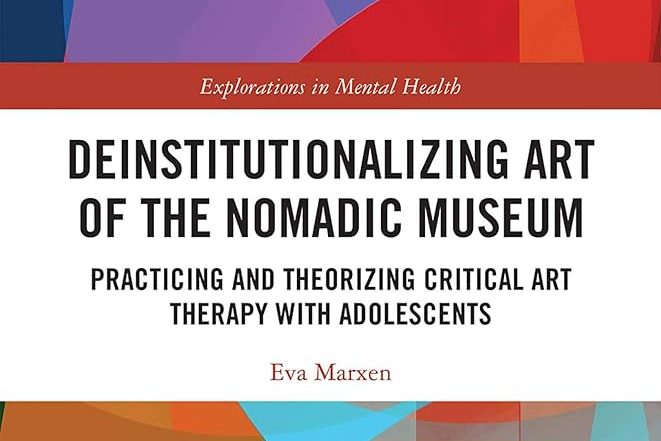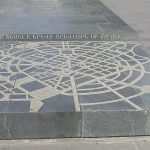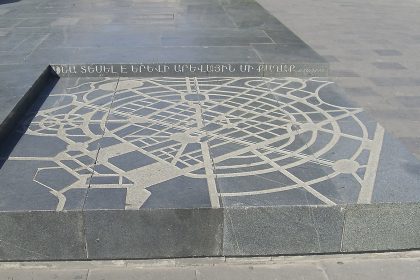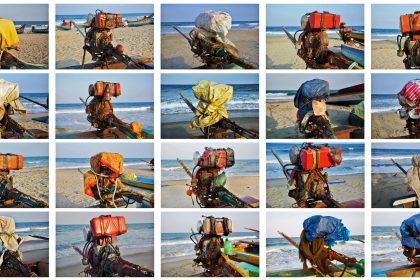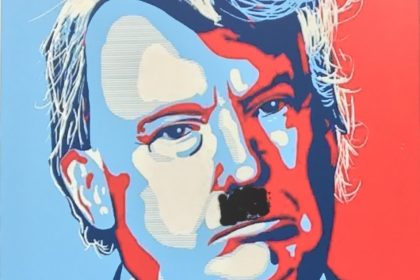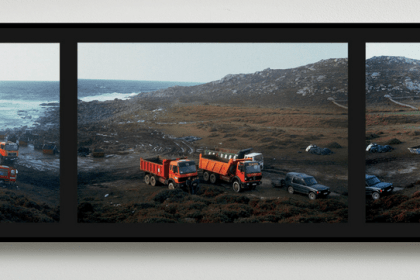Through the Nomadic Museum: Artistic Practice and the Committed Museum
Dr. David Gutiérrez Castañeda
A review of the book Deinstitutionalizing Art of the Nomadic Museum: Practicing and Theorizing Critical Art Therapy With Adolescents by Eva Marxen (2020, Routledge).
Frequently, we think of the contemporary art museum as an institution associated with the values of high culture and the construction of aesthetic projects of artists and their dissemination in cultural spheres. It is not that these assumptions are not relevant in a general cultural policy, but it is also important to defend a certain autonomy of curatorial practice and the work of artists with a certain critical potential that may unfold within audiences and the communities around the museums, cultural processes that are more situated, less referential and more concrete. Even so, the question about the mediation of museums and the question about the cultural experience is much broader. To achieve better representation in museums we need to insist on the rearticulation of their educational, mediation, and social impact projects. In Deinstitutionalizing Art of the Nomadic Museum: Practicing and Theorizing Critical Art Therapy with Adolescents (ed. Routledge, 2020), Eva Marxen proposes a strategy that comes from psychoanalysis, and from the critical theory of Félix Guattari and Gilles Deleuze, in association with Jorge Ribalta. The strategy insists on different operations and dimensions of the museological project of the Museum of Contemporary Art of Barcelona MACBA (1999-2009) and how it has been articulating this political position. This book is a worthwhile read for all those seeking to build another political territory for museums.
This book is also a review of the conceptual and critical apparatuses that MACBA’s mediation and cultural management departments built over the first decade of the 21st century. The museum generates intercultural relations and projects of symbolic connections that can produce different artistic operations. The important practices come from art therapy, performative pedagogical experiments, activities expanded to public spaces, reviews of artists, and analysis of both Latin America and Europe, as applied to youth communities around the museum. This systematization teaches us how an institution can assume a critical role within the formation of communities. In my reading, these commitments display a micropolitical dimension that appears insistently in Guattari’s works, but which in this situation leads to the paradox of the programming processes of a museum. The critical analysis that Marxen makes of this trajectory brings us closer to the tools of Gramsci and Marx in order to insist on a diffracted form in which the subjectivity of the audience not only appears in the contemplative moment of the tour and the guided visit to the artworks. Instead, works with the audience are also long-term processes that are constituted in subtle insistences that occur in the political proposals of the institution.
The articulating axis of the critical door towards the cultural function of the museum, of how these proposals could be shaped, has to do with the path of meaning proposed by Jorge Ribalta. And this is art therapy. This practice reduces the importance of verbal discussion and activates other forms of expression in which one participates in the configuration of alternative languages and reflective experiences. Marxen describes how the client goes through experiences of symbolism and generates rhythms that allow the professional to articulate crises of the dominant culture and consider in turn other types of oral and meaningful interactions. Art therapy is constituted as a healthy, established space to explore different types of vulnerabilities, in working groups and in collectivities, operating and gestating symbolic and expressive forms that allow people to express themselves. But, how to operate this from within the museum? It is clear that the commitment to the workshop and the articulations between entities and institutions that organize cultural processes for adolescents, in particular, become an organizing axis of the community experience. In the case of Ribalta and Marxen we find an understanding of the clinical and political laboratory exercise, turning it into, through Agamben’s concepts, a space for inquiry. Not only to provide a space for emotional compensation for communities or focal working groups, but also a device, an apparatus and a protocol for the constitution of a bibliography and a series of questions that configure artistic training with people who go through emotional challenges.
This type of agreement implies, in Marxen’s account, not only opening the museum to generate conversations regarding each of the experiences of these particular visitors, treated as a proper name, but also implied a displacement of the areas of education and mediation of the museum towards the different social organizations that support the instruments and devices of sustaining subjectivity. The workshop, then, needed psychoanalytic, ethnographic, sociological and anthropological approaches with health, education and social work institutions. These, in turn, are not taken from the place of service provision, but from the territory of encounter and articulation – synergy processes in which art awareness laboratories could in turn be constituted as spaces for the gestation of subjectivity for clients and patients.
This book articulates an anti-psychiatric and anti-programmatic critique of the ways in which art therapy and contemporary art join together and examines how the processes constitute subjectivity in the museum’s audiences, publics, and communities. Marxen responds to this concern beyond the psychiatrization of the aesthetic experience, through analysis of the cultural experience that different Latin American artistic practices have generated. Figures such as Hélio Oiticica, Lygia Clark, Lygia Pape, Oscar Massota, Roberto Jacoby, the experiences of art and politics in Argentina, as well as the cultural resistance projects of different Latin American countries, among others, are taken into account. These are considered as a reference point for how an artist should function, but also as artifacts and devices of relational expansion that constitute not only an exercise at the service of the symptom, but as a possibility of deploying the symptom in different cultural operations. And in this context the museum can act as a platform or a community laboratory. This is clear, considering the approach of a Marxist anthropological critique of the mechanisms of psychic health that, in the company of Gramsci, but also of Michael Taussig and Victor Turner, allows Marxen to understand the processes of interaction of relational rituality.
For Marxen, this political critique of the institutions of medical health implies a need for the museum to become a nomadic entity. Accustomed since cultural and colonial modernity to consider the museum as the building, shelter of symbolic and material artifacts that constitute narratives consequent to the stories of power, this proposal for a museum to be nomadic makes it possible to view it as a living organism between labor, the psychic, the symbolic, the performative, and the poetic. One in which the curatorial and mediation work happens where there are the relational conditions of audience and symbolic experiences that allow one to create or call attention to a significant cultural process. That is why the nomadic museum is not necessarily a museum without a building. Rather, it is a museum that houses laboratories of experience that need to articulate different museological functions, such as the collection, mediation, curatorship, and its exhibitions, as scenarios in which impacts and conversations occur. By changing the meaning of these cultural artifacts, it moves from the individualistic, contemplative gaze of the tourist who visits a delimited cultural object in which a photograph is taken as a casual souvenir of their visit to the museum, to one that moves to a series of interactions, practices, exercises, workshops, performances, plays, actions in different spaces, where the different micropolitical possibilities of the commitment to curate in the museum begin to vibrate and resonate.
It is true that the question of the healing faculties of art or artistic practice leave traces of debate that should not be underestimated. The conception of art that emerges from Marxen’s analysis during her time working at MACBA insists on considering a commitment closer to the notion of an artistic practice than to the notion of a work of art. This does not mean, as we know based on the work of Ileana Diéguez, that there is no agency of authorship in the articulation of experience, in the case, for example, of Marxen’s important visit to the Latin American Art and Politics conglomerate of the 1960s and 70s, where agents, practices, works and gestures are identified that have the potential to be experienced at the moment in which activities and processes are generated through these semiotic-political coordinates [1]. As Marxen notes: “… The artistic dispositif facilitates precisely this searching, mostly in a visual way, favoring heterogeneous expression [of subjective existence]. At the same time, it gives room for uncertainties, thus opposing over-codification and automatic answers, and also the conditions of articulation and symbolization…” (Marxen, p. 103).
The issue then is the question about the late modern configuration of the museum where we must change our imaginary that an artist is an operator who generates a significant materiality that is enhanced by the interactive exhibition work and that it is the function of the museum to safeguard those conditions of gaze in which the poetic setting becomes discernible. When we think of a nomadic museum, under the specters of Benjamin and Brecht, we are thinking of a museum that is constituted as a cultural center of practices. These practices have very different and diverse genealogies that remind us of the discussion about activation that had been already proposed in the same coordinates by Jorge Ribalta and Suely Rolnik around the year 2006. For Rolnik, activation is not an exercise of mediating the meaning of a work of art [2]. In its coordinates of political clinic, activation consists of understanding from a point of view the different fields of force and possibilities that allow the work to produce experiences. The work can be in the collection or the artwork, it can be conceived from the graphic or the theatrical point of view, in sculpture, painting or from a relational action. Activation does not mean giving meaning to the support for a spectator, but rather semantically exploring the support in a set of practical orientations that allow the audiences to develop from their bodies a singular experience where the poetic invitation of the work has a hold on their sensibilities, their affections, and their different ways of constructing points of view and reflection.
Considering this important commitment in a contemporary art museum then consists of reading the collection, and reading the aesthetic-political collections in the same key. Not of communicating meanings but of generating laboratories of experience that allow exploring and generating incidents within the contacts and contagions of these poetics when they become concrete activities with a mediator or an artist. This is the singular commitment between subjectivity and art that Marxen pursues. The museum stops having an education department to become an educational apparatus: from the building to the rhizomatic. The artist accomplices from Dora Garcia, Iconoclasistas, Roberto Jacoby, Graciela Carnevale, Antonio Muntadas, Esther Ferrer, Martha Rosler, Nancy Spero, among others, do not generate works to be signified but rather works to be constructed in different experimental curatorial approaches. Joining Ana Longoni’s ideas, Marxen explains: “Artists have created a space of experimentation, in opposition to capitalism, facilitating an experimentation of utopia and subjectivity as alternatives to normalization. New ways of inhabiting the world are evidenced, deconstructing institutional models and point of views. The possibility of change through agency is transmitted mainly through images. At the same time, a critical analysis is undertaken by questioning hegemony” (Marxen, p.133).
This commitment to the nomadic museum is not free from limits, tensions and contradictions, and has to do with bringing to the forefront of the debate the strategies of legibility and articulation that for specific communities of certain specific experimental works. But it also implies the questioning of the political instrumentality of art. From a clinical-political position, Marxen’s work teaches us that instrumentalization is a word loaded with many biases and prejudices from a functionalist and disciplinary perspective of the symbolic affectation in the therapeutic framework. Remembering Suely Rolnik again: if art cures, this political psychic process does not happen as if it were a medicine or a drug. It does not execute demonstrable changes in an “effective” way in the psychic constitution of communities. Art alone is just not effective. In that sense, museums are laboratories of psychic support that can be activated in the specific cartographies of the communities of meaning in which they are carrying out the work. In this sense, and it is important to clarify this, the museum is at the service of the experiences of the community of meaning and not the other way around. This is the key in the risks of imagining a new cultural policy, the curatorial exercise and the exercise of mediation. The exercise of activation must understand the community in its stakes, its challenges, its tensions, its contradictions and it shares micropolitically the caress of a gesture and the production of symbolic meanings through an act. This is not minor, although it is not redemptive. This is the commitment to deinstitutionalization Marxen invites us to from the anti-psychiatric debates of which she makes an extensive and clear genealogy in chapter six.
This book is an important resource for educators and therapists who want to participate in the civic and political responsibility of museums, mediators and curators who accept the political challenge of moving and being nomadic with respect to exhibition spaces and want to relationally affect their communities more insistently, and for art historians and critical theorists who want to think about the different ways in which a set of practices of a specific history has been deployed from anti-psychiatry, critical curatorship, cultural politics, and the activation of contemporary art. Marxen invites us to theorize and go through experiences in museums. To question what constitutes a democratic culture. The arts are not underestimated, but are in turn expanded and explored in fields of influence that are perhaps beyond what the artists intended through their works.
Dr. David Gutiérrez Castañeda is a sociologist with a Ph.D. in Art History (2016) from the National Autonomous University of Mexico with an emphasis on performance studies, gender, ecology, art, museology and politics in Latin America. His dissertation, Exercises of Care: About The Skin of Memory investigated cultural and artistic performances as practices of care. He teaches and coordinates programs at the National School of Higher Studies Unidad Morelia (ENES), UNAM, and runs the Seminar on Performance Studies and Living Arts (SepaVivas) and the artistic residency program. He is a member of the research collective Taller de Historia Crítica del Arte and the Red de Conceptualismos del Sur. He has been a visiting professor at the Faculty of Arts of the National University of Colombia in 2018, in addition to the Karlsruhe Institute of Technology in Germany, the State University of Rio de Janeiro in Brazil and the National University of San Martín in Argentina in 2023. He is the winner of the National Prize for Art Criticism from the Ministry of Culture of Colombia in 2010 and the National University Recognition for Young Academics in Research in Arts at the UNAM in 2022. His publications include: From Genres to Care: Pedagogical Practices to Reflect on Intimacies in Public Institutional Contexts (Papime PE404818), Enlivening the Common Environmental Horizon: Pedagogical Encounters between Arts and Political Ecology (Papime PE402519), and Between Field and Field: Operations, Practices and Pedagogical Gestures between Agroforestry and Arts ( Papime PE404223). He is the author of academic articles and the book Mapa Teatro 1987-1992 (2014).
Notes
[1] Ileana Diéguez, Escenarios Liminales.Teatralidades, Performatividades, Políticas; Ed. Paso de Gato: Ciudad de México, 2014.
[2] Suely Rolnik, ¿El Arte Cura? Ed. Museo de Arte Contemporáneo de Barcelona (MACBA), 2006: https://www.macba.cat/en/publications/el-arte-cura-2/

